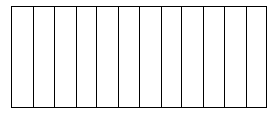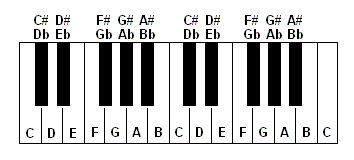Chromatic Scale
Imagine a keyboard with nothing but white keys:

It would be very difficult to keep track of which note was which. Early keyboards were a bit like this until someone had the idea of painting some of the keys black:

Then an even brighter and better idea - the black keys were narrowed and raised in height so that the player could find individual keys by touch alone:

The clever part of all this is the pattern of black notes grouped as they are in twos and threes, enabling the player uniquely to identify each note on the keyboard.
Understanding the Chromatic scale (continued)
The white (natural) notes are defined as follows:
C positioned just to the left of the group of two black notes
D positioned between the two black notes
E positioned just to the right of the group of two black notes
F positioned just to the left of the group of three black notes
G positioned between the first two out of the group of three black notes
A positioned between the second two out of the group of three black notes
B positioned just to the right of the group of three black notes
D positioned between the two black notes
E positioned just to the right of the group of two black notes
F positioned just to the left of the group of three black notes
G positioned between the first two out of the group of three black notes
A positioned between the second two out of the group of three black notes
B positioned just to the right of the group of three black notes
The black notes each have two possible names depending on whether you are looking up at them from the note below or down at them from the note above.
C# is just to the right of C and can also be called Db because it's just to the left of D
D# is just to the right of D and can also be called Eb because it's just to the left of E
F# is just to the right of F and can also be called Gb because it's just to the left of G
G# is just to the right of G and can also be called Ab because it's just to the left of A
A# is just to the right of A and can also be called Bb because it's just to the left of B
D# is just to the right of D and can also be called Eb because it's just to the left of E
F# is just to the right of F and can also be called Gb because it's just to the left of G
G# is just to the right of G and can also be called Ab because it's just to the left of A
A# is just to the right of A and can also be called Bb because it's just to the left of B
But notice that there is no E#, Fb, B# nor Cb because we have to leave a gap in the pattern of black notes at these points or the poor keyboard player would be right back where we started.
The chromatic scale is best learned in both directions:
Ascending using sharp (#) names: C C# D D# E F F# G G# A A# B C and
Descending using flat (b) names: C B Bb A Ab G Gb F E Eb D Db C
Descending using flat (b) names: C B Bb A Ab G Gb F E Eb D Db C
The guitar fretboard is arranged chromatically and knowing this scale is the key to working out all the notes on your guitar. For example, here are the notes on the E string:

See if you can apply this scale to figure out the notes on the other strings.
Summary

 Naturally occurring half steps exist between B/C & E/F (no sharp or flat between). B goes directly to C, and E goes directly to F. [B# is C, Cb is B, E# is F, Fb is E].
Naturally occurring half steps exist between B/C & E/F (no sharp or flat between). B goes directly to C, and E goes directly to F. [B# is C, Cb is B, E# is F, Fb is E].
A note that is 2 half steps away from a given tone is called a whole step (w or 2; on guitar a whole step is 2 frets). Example: C to D. The whole step should not be confused with the whole note ( ) in musical notation (rhythmic duration).
) in musical notation (rhythmic duration).
Summary
Western music uses a 12 tone system called Equal Temperament (equally spaced half steps). 7 naturals, & 5 sharps/flats. These tones are one half step (h - on guitar, a half step is 1 fret) to the next adjacent tone (Equal Temperament). Just Intonation is another system of tuning based on the pure vibrations of nature (where the harmonics of a given tone are the basis of the tuning - only that key is in 'perfect' tune).
One possible relationship between colors & music tones [sharps & flats utilize stars & some outlines to differentiate them]:

The 12 Tones
The 12 consist of:- 7 Naturals [white keys on the piano] - A - B - C - D - E - F - G, then back to A
- 5 Sharps (#)/Flats (b) - [black keys on the piano] - A#/Bb - C#/Db - D#/Eb - F#/Gb - G#/Ab

A note that is 2 half steps away from a given tone is called a whole step (w or 2; on guitar a whole step is 2 frets). Example: C to D. The whole step should not be confused with the whole note (


Post a Comment